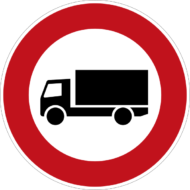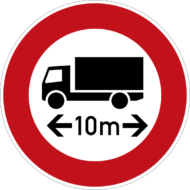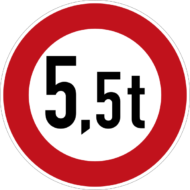Important traffic signs when towing a trailer (Part 3)

Traffic signs for vehicle combinations
Although the following traffic signs are relevant for towing a trailer, they only apply if the combination weighs more than 3.5 tons and the towing vehicle is neither a bus nor a car. So let’s assume that you mostly travel with a car and trailer, then these traffic signs are only important for you if your vehicle combination is particularly heavy. Again and again, drivers are unclear as to whether the following signs are relevant to them or not. In the following we summarize the most important information about the traffic signs for vehicle combinations.
The prohibition sign for trucks

Prohibition sign for heavy vehicles
Based on the actual mass of a motor vehicle, this round prohibition sign indicates how heavy a
vehicle may be in order to continue driving on the affected road. However, the plate refers to the actual mass (what the vehicle actually weighs), not the gross vehicle weight rating (what the vehicle is allowed to weigh). If you are traveling with a vehicle combination, for example with a trailer, then the weight of the individual vehicles is relevant, not the weight of the combination.
The length of your vehicle on traffic signs

an indication of its length. The sign states that you would need to consider the actual length of the entire vehicle combination. If your team is longer than indicated on the sign, then you are not allowed to drive into the street. If you continue to drive, it may for example be the case that you will not be able to turn around in an emergency or that curves are too narrow for you. As with the other signs, a fine will be imposed for disregarding the sign.


 Not only are pick-ups visually different, they are also not exactly ordinary in terms of their pulling power and their use. Pick-ups are mainly used in agriculture, the construction industry and forestry and are characterized by their large loading platform and their high towing power.
Not only are pick-ups visually different, they are also not exactly ordinary in terms of their pulling power and their use. Pick-ups are mainly used in agriculture, the construction industry and forestry and are characterized by their large loading platform and their high towing power. If you get a new trailer, then you should definitely plan the trip to the registration office. A trailer for a car is not registration-free and you have to get official license plates in addition to the registration. In order to get this and to be able to use your new trailer for the first trip, you have to register your trailer. You can only use it in road traffic with a valid license.
If you get a new trailer, then you should definitely plan the trip to the registration office. A trailer for a car is not registration-free and you have to get official license plates in addition to the registration. In order to get this and to be able to use your new trailer for the first trip, you have to register your trailer. You can only use it in road traffic with a valid license. Of course, before you retrofit a trailer hitch, you first have to determine whether your car has ever been designed to travel with the trailer and is approved as a towing vehicle. You can find all the information you need on the nameplate of the vehicle. The data are both in the service booklet and usually on a sticker that is housed in the spare wheel module. If it can not be found there, you will find information in the owner’s manual of the vehicle on where to findyour nameplate. In addition to the vehicle manufacturer and the approval number, the chassis number can also be found there. The second line also specifies technically permissible weights. Underneath you will also find the permissible trailer weight.
Of course, before you retrofit a trailer hitch, you first have to determine whether your car has ever been designed to travel with the trailer and is approved as a towing vehicle. You can find all the information you need on the nameplate of the vehicle. The data are both in the service booklet and usually on a sticker that is housed in the spare wheel module. If it can not be found there, you will find information in the owner’s manual of the vehicle on where to findyour nameplate. In addition to the vehicle manufacturer and the approval number, the chassis number can also be found there. The second line also specifies technically permissible weights. Underneath you will also find the permissible trailer weight.